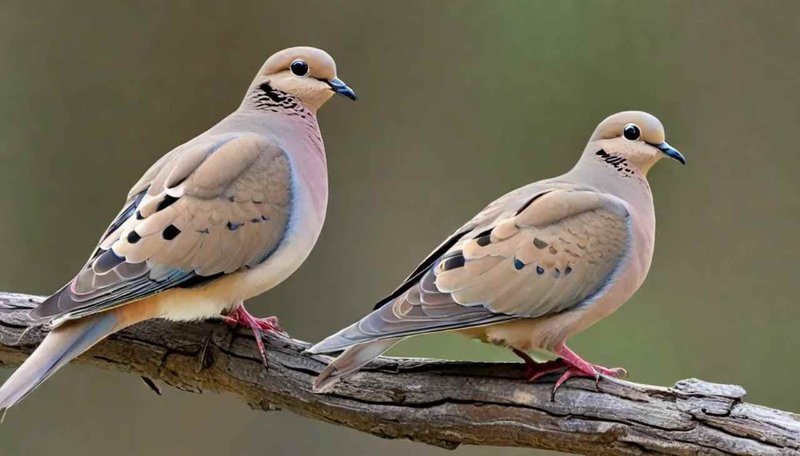
In the world of doves, their beauty isn’t just in their soft cooing voices or gentle presence; it also lies in their unique behaviors and physical traits. Picture sitting in a sunny garden, watching these birds interact. You might notice one has a slightly different shape or behavior than the other. Let’s dive into a few straightforward observations that can help you distinguish between male and female doves with ease.
Physical Differences Between Male and Female Doves
One of the most straightforward ways to tell male and female doves apart is by observing their physical characteristics. Generally, male doves tend to be larger, but that’s not the only feature to note. For instance, males often have a more robust appearance. Their heads might appear slightly larger compared to females, giving them a more pronounced silhouette.
Another interesting aspect is the *coloration* of their feathers. Males often display brighter and sharper colors as a way to attract females. You might see their plumage shining in the sun, while females usually have softer, more muted tones. This difference is particularly noticeable in species like the *Eurasian collared dove*, where the male exudes a more vibrant appearance.
Additionally, consider the shape of their bodies. Male doves generally have a more rounded body and a wider tail compared to females. If you’re watching them from afar, this distinction can be a helpful clue when trying to identify who’s who.
Behavioral Differences of Male and Female Doves
Behavior can also give you a clear hint about whether you’re looking at a male or female dove. Male doves are often more active in displaying courtship behaviors. You’ll see them puffing out their chests, bobbing their heads, and even cooing more loudly when trying to impress a mate. This enthusiastic show is all about gaining the attention of the females nearby.
On the other hand, females usually exhibit more nurturing behaviors, especially when it comes to nesting. If you notice a dove busily arranging twigs and leaves while being a bit shy, it’s probably a female. She’s likely preparing a safe space for potential eggs.
Here’s the thing: observing these behavioral traits can not only help you identify their gender but also offer insight into their roles in the dove community. Witnessing these gentler interactions adds another layer to your understanding of their lives.
Differences in Vocalizations
Dove sounds are beautiful, but they also carry messages. Males tend to have deeper, more resonant cooing sounds. When they call out, their voices often carry a certain richness that stands out. Listen closely, and you might pick up a variety of tones that suggest excitement or even territorial claims.
Females, however, often have softer, more delicate coos. Their sounds may fade quicker and can sometimes seem more melodious compared to the males. If you’re lucky enough to hear a pair of doves communicating, the contrast between their vocalizations can be quite charming!
You might be wondering why these differences exist. Well, they are largely tied to mating rituals. Males use their vocal prowess to attract females, while females respond with their gentler sounds as part of their nurturing roles.
Eye Differences: A Closer Look
Now, let’s get a bit detailed about their eyes. If you take the time to observe closely, you may find differences in their eye color. Males often have more vibrant eyes, which can appear brighter and sharper compared to females. This brightness is another aspect of their display to attract mates.
Take note too of the position of their eyes. Males generally have a slightly more pronounced gaze, as they are often on the lookout for rivals while also trying to catch the attention of a female. When watching doves interact, try focusing on their eyes—it’s a part of their body language that can tell you a lot about what they’re feeling or trying to express.
This attention to their eyes can also enhance your bond with these birds. Knowing these subtle traits can deepen your appreciation for what makes each dove unique.
Size and Weight: A Gentle Giant?
Size matters when it comes to doves. Generally, males are larger and weigh more than females. This heavier frame is particularly noticeable in larger dove species like the *mourning dove* or *rock dove*. If you’re able to observe doves side by side, you might find the male to be a little bulkier.
While watching, consider not just their weight but also how it affects their movement. Males often exhibit more confidence in their movements, strutting around with assurance. They might engage in playful fights more often, flaunting their size. Females, on the other hand, tend to be slightly more reserved, especially in new environments.
If you’re looking to adopt a dove, understanding this size difference can also help you make informed decisions about housing and care, ensuring both male and female feel comfortable in their space.
Typical Breeding Patterns: Understanding Their Roles
When it comes to breeding, things get pretty interesting. It’s worth noting that male doves take on an active role during courtship. They perform elaborate displays, such as bowing and puffing up their feathers. Males are often the ones to initiate courtship and find a nesting site, which they then proudly defend.
Females are critical in this process too, as they typically choose their mates based on these displays. They’re selective, often going for a male that shows strength, health, and confidence. This dynamic is not only fascinating but also essential for the continuation of their species.
Understanding these roles gives you insight into their daily lives. By observing these patterns, you can appreciate how doves interact with each other and their environment, and why distinguishing between them is more than just a fun fact.
Being able to tell male and female doves apart can significantly enhance your experience as a birdwatcher or pet owner. Watching these charming creatures interact provides a window into their behaviors, roles, and the subtle beauty of nature.
Now that you’ve learned how to spot the differences—whether it’s through physical traits, vocalizations, or behaviors—you’re equipped with the knowledge to appreciate doves even more. Next time you’re in a park or your backyard, take a moment to observe these lovely birds. You might just find yourself seeing your surroundings in a whole new light!

